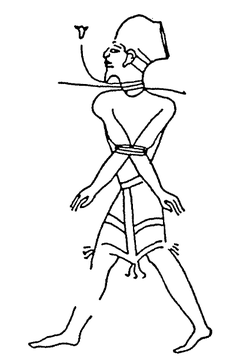சாசூ மக்கள்

சாசூ மக்கள் (Shasu), எகிப்தின் மூன்றாம் இடைநிலைக் காலத்தின் |(கிமு 1069 - கிமு 664) போது, பண்டைய அண்மை கிழக்கின், தெற்கு லெவெண்ட் பிரதேசத்தில் செமித்திய மொழி பேசும் கால்நடைகளை மேய்த்துக் கொண்டு, கூடாரங்களிள் தங்கி வாழும் நாடோடிக் குழுவினர் ஆவார். சாசூ மக்கள் அதிகமாக சினாய் தீபகற்பம்[1], கானான் தேசம் மற்றும் தற்கால இஸ்ரேல் வடக்கு மற்றும் தெற்கு பகுதிகளில் அதிகம் வாழ்ந்தனர்.இமக்களில் சிலர் பண்டைய எகிப்திய இராச்சியத்தினருக்கும் மற்றும் மெசொப்பொத்தேமியா இராச்சியத்தினருக்கும் கூலிப்படையினராக செயல்பட்டனர்..[2] சில அறிஞர்கள் சாசூ மக்களை இசுரயேலர் மற்றும் யாவே கடவுளுடன் தொடர்புறுத்தி பேசுகின்றனர்.
வரலாறு[தொகு]
கிமு 15ம் நூற்றாண்டுகளில் சாசூ மக்கள் குறித்த குறிப்புகள் ஜோர்டான் பகுதிகளில் காணப்படுகிறது. மேலும் பண்டைய எகிப்தியர்களின் எதிரிகளின் பட்டியலில் சாசூ மக்கள் உள்ளனர் என்பதை மூன்றாம் அமென்கோதேப் (கிமு 1391–1353) தற்கால வடக்கு சூடான் நாட்டின் சொலெப் கோயில் தூண்களில் பொறிக்கப்பட்டதன் மூலம் அறியப்படுகிறது.[3][4] . எகிப்திய மன்னர்களான இரண்டாம் ராமேசஸ் மற்றும் மெர்நெப்தா ஆட்சிக் காலங்களில் சாசூ மக்கள் எகிப்து, கானான் தேசங்களிலிருந்து தறால ஜோர்டான் பகுதிகளுக்கு விரட்டியடிக்கப்பட்டனர். எகிப்து இராச்சியம் வீழ்ச்சியடைந்த பின்னர் சாசூ மக்கள் மீண்டும் சாசூ மக்கள் கானான் தேசத்தின் குடியேறினர்.[2] கடல் மக்களின் வருகையால் இறுதியில் சாசூ மக்கள் மறைந்து போயிருக்கலாம் எனக்கருதப்படுகிறது..[2]
சாசூ மக்களின் யாவே (Yhw) கடவுள்[தொகு]

மூன்றாம் அமென்கோதேப் (கிமு 14ம் நூற்றாண்டு) மற்றும் இரண்டாம் ராமேசஸ் (கிமு 13ம் நூற்றாண்டு) காலத்திய இரண்டு எகிப்திய நூல்களில் சாசூ மக்கள் வழிபட்ட யாவே கடவுள் குறித்த குறிப்புகள் உள்ளது.
மேற்கோள்கள்[தொகு]
- ↑ Miller 2005, ப. 95.
- ↑ 2.0 2.1 2.2 Younker 1999, ப. 203.
- ↑ Sivertsen 2009, ப. 118.
- ↑ Hasel 1998, ப. 219.
ஆதாரங்கள்[தொகு]
- Ahlström, Gösta Werner (1993). The History of Ancient Palestine. Fortress Press. பன்னாட்டுத் தரப்புத்தக எண்:978-0-8006-2770-6. https://books.google.com/books?id=5cSAlLBZKaAC&pg=PA277.
- Astour, Michael C. (1979). "Yahweh in Egyptian Topographic Lists". Festschrift Elmar Edel. Bamberg. இணையக் கணினி நூலக மையம்:464504316. https://www.worldcat.org/oclc/464504316.
- William G., Dever (1997). Bartlett, John R.. ed. "Archaeology and the Emergence of Early Israel". Archaeology and Biblical Interpretation (Routledge): 20–50. doi:10.4324/9780203135877-7. பன்னாட்டுத் தரப்புத்தக எண்:9780203135877. https://www.taylorfrancis.com/chapters/edit/10.4324/9780203135877-7/archaeology-emergence-early-israel-william-dever.
- Hasel, Michael G. (1994). "Israel in the Merneptah Stela". Bulletin of the American Schools of Oriental Research 296 (296): 45–61. doi:10.2307/1357179. https://www.jstor.org/stable/1357179.
- Hasel, Michael G. (1998). "Domination and Resistance: Egyptian Military Activity in the Southern Levant, 1300–1185 BC.". Probleme der Ägyptologie (Brill) 11: 217–239. பன்னாட்டுத் தரப்புத்தக எண்:9004109846. https://books.google.com/books?id=cwHL6yzrqLgC&q=Domination+and+resistance:+Egyptian+military+activity+in+the+southern+Levant.
- Hasel, Michael G. (2003). "Merenptah's Inscription and Reliefs and the Origin of Israel (The Near East in the Southwest: Essays in Honor of William G. Dever)". Annual of the American Schools of Oriental Research (Boston: American Schools of Oriental Research) 58: 19–44. பன்னாட்டுத் தரப்புத்தக எண்:0897570650. https://www.jstor.org/stable/3768554.
- Hen, Racheli S. (2022). "Signs of YHWH, God of the Hebrews, in New Kingdom Egypt?". Entangled Religions 12 (2). doi:10.46586/er.12.2021.9463. பன்னாட்டுத் தர தொடர் எண்:2363-6696. https://d-nb.info/1258383969/34.
- Hoffmeier, James K. (2005). "Ancient Israel in Sinai". Buried History, 41, 2005, 69-70 (Oxford University Press): 240–45. https://www.academia.edu/4616592.
- Levy, Thomas E.; Adams, Russell B.; Muniz, Adolfo (January 2004). Le-David Maskil: A Birthday Tribute for David Noel Freedman. Eisenbrauns. பக். 66–. பன்னாட்டுத் தரப்புத்தக எண்:978-1-57506-084-2. https://books.google.com/books?id=1BLaEv98ClkC&pg=PA66.
- Steven Grosby (2007). Nationalism and Ethnosymbolism: History, Culture and Ethnicity in the Formation of Nations. Edinburgh University Press. பன்னாட்டுத் தரப்புத்தக எண்:9780748629350. https://books.google.com/books?id=aNuqBgAAQBAJ&q=Seir.
- MacDonald, Burton (1994). "Early Edom: The Relation between the Literary and Archaeological Evidence". Scripture and Other Artifacts: Essays on the Bible and Archaeology in Honor of Philip J. King. Westminster John Knox Press. பக். 230–246. பன்னாட்டுத் தரப்புத்தக எண்:0664223648. https://biblio.ebaf.edu/bib/359725.
- Miller, Robert D. (2005). "Chieftains of the Highland Clans: A History of Israel in the 12th and 11th Centuries B.C.". Near Eastern Archaeology (Wm. B. Eerdmans Publishing) 69 (2): 99. doi:10.1086/NEA25067653. https://www.journals.uchicago.edu/doi/10.1086/NEA25067653.
- Nestor, Dermot Anthony (2010). "Cognitive Perspectives on Israelite Identity". Reviews in Religion & Theology (Continuum International Publishing Group) 19 (1): 141–143. doi:10.1111/j.1467-9418.2011.00993.x. https://onlinelibrary.wiley.com/doi/abs/10.1111/j.1467-9418.2011.00993.x.
- Anson Rainey (2008). "Shasu or Habiru. Who Were the Early Israelites?". Biblical Archaeology Review 34 (6).
- Donald B. Redford (1992). Egypt, Canaan and Israel In Ancient Times. Princeton: Princeton University Press. பன்னாட்டுத் தரப்புத்தக எண்:0-691-00086-7. https://archive.org/details/egyptcanaanisrae00redf.
- Thomas Schneider (Egyptologist) (2007). "The First Documented வார்ப்புரு:As written of the God Yahweh? (Book of the Dead Princeton "Roll 5")". Journal of Ancient Near Eastern Religions 7 (2): 113–120. doi:10.1163/156921207783876422. https://doi.org/10.1163/156921207783876422.
- "Dictionary of Archaeology".. (2008). John Wiley & Sons. பன்னாட்டுத் தரப்புத்தக எண் 9780470751961.
- Sivertsen, Barbara J. (2009). The Parting of the Sea: How Volcanoes, Earthquakes, and Plagues Shaped the Story of Exodus. Princeton University Press. பன்னாட்டுத் தரப்புத்தக எண்:9780691137704. https://books.google.com/books?id=HBNWqXHC0MYC&dq=%22Shasu+of+Seir%22&pg=PA118.
- Sparks, Kenton L. (1998). Ethnicity and Identity in Ancient Israel: Prolegomena to the Study of Ethnic Sentiments and Their Expression in the Hebrew Bible. Eisenbrauns. doi:10.5325/j.ctv1w36q0h. பன்னாட்டுத் தரப்புத்தக எண்:9781575065168. https://www.jstor.org/stable/10.5325/j.ctv1w36q0h.
- Lawrence Stager (2001). "Forging an Identity: The Emergence of Ancient Israel". in Coogan, Michael. The Oxford History of the Biblical World. Oxford University Press. பக். 90–129. பன்னாட்டுத் தரப்புத்தக எண்:0195087070. https://ixtheo.de/Record/1589208420.
- Karel van der Toorn (1996). Family Religion in Babylonia, Ugarit and Israel: Continuity and Changes in the Forms of Religious Life. Brill. பன்னாட்டுத் தரப்புத்தக எண்:9004104100. https://books.google.com/books?id=VSJWkrXfbLQC.
- Adrom, Faried; Müller, Matthias (2017). "The Tetragrammaton in Egyptian Sources – Facts and Fiction". The Origins of Yahwism. De Gruyter. பக். 93–. doi:10.1515/9783110448221. பன்னாட்டுத் தரப்புத்தக எண்:9783110448221. https://doi.org/10.1515/9783110448221.
- Younker, Randall W. (1999). "The Emergence of the Ammonites". in MacDonald, Burton; Younker, Randall W.. Ancient Ammon. BRILL. பக். 203. பன்னாட்டுத் தரப்புத்தக எண்:978-90-04-10762-5. https://books.google.com/books?id=5Sm7BOubDYcC.
- Frank J. Yurco (1986). "Merenptah's Canaanite Campaign". Journal of the American Research Center in Egypt 23: 189–215. doi:10.2307/40001099. https://www.jstor.org/stable/40001099.
